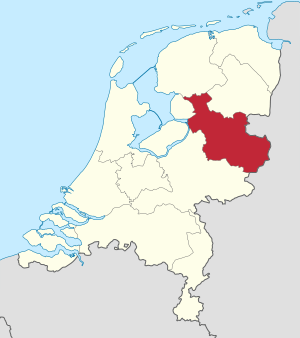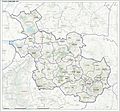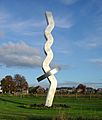Overijssel facts for kids
Quick facts for kids
Overijssel
|
|||
|---|---|---|---|
|
|||
| Anthem: "Aan de rand van Hollands gouwen" "On the edge of Holland's district" |
|||

Location of Overijssel in the Netherlands
|
|||
| Country | Netherlands | ||
| Capital | Zwolle | ||
| Largest city | Enschede | ||
| Area | |||
| • Total | 3,327 km2 (1,285 sq mi) | ||
| • Water | 94 km2 (36 sq mi) | ||
| Area rank | 4th | ||
| Population
(2015)
|
|||
| • Total | 1,142,360 | ||
| • Rank | 7th | ||
| • Density | 343.36/km2 (889.30/sq mi) | ||
| • Density rank | 7th | ||
| ISO 3166 code | NL-OV | ||
| Religion (2006) | Protestant 29% Catholic 26% Muslim 2% Others 6% Non-religious 37% |
||
| HDI (2017) | 0.917 very high · 7th |
||
| Website | www.overijssel.nl | ||
Overijssel (Latin: Transisalania) is a province of the Netherlands. It is in the central eastern part of the country. The province's name in both Dutch and Latin means "Lands across river IJssel". The capital city of Overijssel is Zwolle. Its biggest city is Enschede.
Geography
Overijssel has Germany to the east. The Achterhoek region of Gelderland lies to the south, the Veluwe region of Gelderland and Flevoland are to the west, and Friesland and the former moors of Drenthe to the north. Overijssel is made of three regions: Kop van Overijssel in the northwest, Salland in the centre of the province, and Twente in the east. Besides the capital Zwolle, the major cities are Almelo, Deventer, Enschede, and Hengelo.
To the southeast, the land is mostly sandy. There are small rivers and brooks cutting through it. Examples for such rivers are Regge and Dinkel. In the northwest, the geology is mostly made of sediments from the Overijsselse Vecht and clay. The northern parts were once covered by veen (bogs) which separated the dryer and more arable south from Drenthe. These bogs have been exploited as fuel to a large degree. Only small patches survive today (Engbertsdijksvenen near Tubbergen, Witteveen (near Haaksbergen), and the Aamsveen (near Enschede). The extreme northwest is dominated by a system of lakes formed by former peat-mining, the Weerribben, which is a valuable wetland.
The highest point in Overijssel is the summit of the Tankenberg, a hill in the municipality of Losser. It is 89 metres (295 ft). The lowest point is in the Mastenbroek Polder near Kampen at 2 metres (6 ft) below sea level.
History
Overijssel was formerly known as Oversticht. In 1336, it was made part of Guelders. It was given to the Bishopric of Utrecht in 1347. Utrecht was known as het Sticht. The Bishops gave the Oversticht to the Emperor Charles V in 1528, who styled himself "Lord of Overijssel". With this, he gave the province its modern name. The people joined with the other Dutch and rebelled against Charles' heir Philip II. Overijssel became governed by the most powerful mayors and lords in the province.
After a brief occupation by the forces of the Bishop of Münster (1672–1674), Overijssel received a new form of government. This granted the stadtholders more power. Widespread resistance against the bigger power throughout the provinces lead to the Batavian Republic in 1795. A centralist government arose and the Netherlands was organised into a series of départements, based on those used by revolutionary France. At first organised into its own département, it was merged with Drenthe in 1798 to form Ouden Ijssel, which was renamed Overijssel in 1801.
The French annexed the Batavian Republic in 1810, and Overijssel was organised into the new French département of Bouches-de-l'Yssel. After the defeat of Napoleon in 1814, the kingdom of the Netherlands and the former province of Overijssel were recreated. Overijssel was briefly occupied by Nazi Germany during World War II from May 1940, until its liberation in April 1945. The Noordoostpolder, which had been laid dry in 1942, was part of Overijssel from 1962 until 1986, when it became part of the newly created province of Flevoland.
Municipalities
Images for kids
-
Rijksweg N35 Ceintuurbaan in Zwolle
-
The Grote Markt in Zwolle, the provincial capital
-
The Bergkerk from the Bergstraat, Deventer
-
Water tower at the Jannink building in Enschede
See also
 In Spanish: Provincia de Overijssel para niños
In Spanish: Provincia de Overijssel para niños











